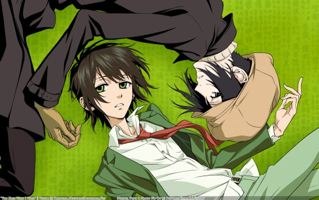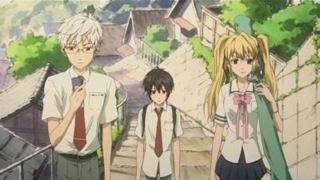By far, Nabari is one of the best anime series released in 2009.
2009 TV Series (episodes 14-26). Director: Kunihisa Sugishima. 325 minutes. DVD, bilingual, $59.98. Distributor: Funimation.
The warring states period and the age of the samurai may have ended long ago, but the ninja are alive and kicking, working in the shadows. They call their world “Nabari.” And the men and women of Iga are at war amongst themselves to control it. Unfortunately, all hope rests with Miharu Rokujou, a teenager more interested in running a restaurant than the fact that the Shinra Banshou, a secret art containing all ninja knowledge, resides inside him. Apathy, however, can only get you so far. Eventually someone always comes knockin.’
That is how I succinctly described the tale of Nabari in my earlier review of part one. And, for the most part, it still holds. Tobari, Koichi, and Raimei are once again at labor to find and protect Miharu. But unlike the initial episodes, part two largely abandons comic antics and lighthearted banter in favor of pursuing a more serious story arc, one only hinted at before. The high school setting, in which these friends formerly moved, has given way to the streets of Japan at large.
In part one we saw the friendship between Miharu and Yoite (his supposed enemy) form as they began to play out the secret of the Shinra Banshou. The two went “rogue” – in a very non Sarah Palin way – in order to reveal Mirahu’s destiny. Now, as more clans become submerged in this power struggle, the elder ninja Tojuro Hattori unleashes a plan to capture the Shinra Banshou and alter the world of Nabari and humans forever. And the more Yoite uses his kira technique to protect Miharu, the more it drains his life force. Everyone is being hurled toward a climaxing, crisis point.
Nabari part two instigates a chain reaction that moves like a runaway train. While I enjoyed the first half, I just couldn’t look away from the second. And since frame-by-frame is filled with action and meaningful detail, the series, much to my disappointment, was over before I knew it. Miharu and Yoite’s friendship still dominates the scene. But, as I said before, character development is strong in Nabari. Meaningful evolutions are not only seen in Koichi and Raimei, but Raiko Shimizu and his intent to fight for the greater good remarkably take center stage. The tragic tale of the last samurai of the Shimizu clan is worthy of its own anime. Unfortunately, like all the rest, you get very attached to the fragments of lives surrounding Miharu. You want more. Then it’s over.
Fortunately, Hattori’s plan doesn’t disappoint either. The climax luring all these characters together is good story telling. The original work of Yuhki Kamatani was clearly borne of something other than the commercial capitalization of ninja, or the plan to sale more toys to children.
And yes, Nabari does come to an end. The last episode contains neither action nor ninja tricks. There is only the life that remains.
By far, Nabari is one of the best anime series released in 2009 (originally airing in Japan in 2008).









